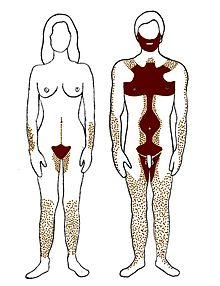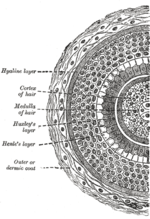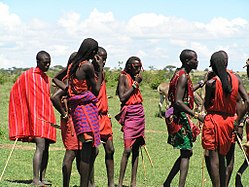Hair

- Hair is also the name of a musical, see respective articles for the stage production and the movie.
Hair is a filamentous outgrowth of dead cells from skin, found only on mammals. Although many other life forms, especially insects, show filamentous outgrowths, these are not considered "hair" in the accepted meaning of the term.
The primary component of hair fiber is keratin. Keratins are proteins, long chains (polymers) of amino acids. Keratin proteins form the cytoskeleton (miniature skeleton within a cell) of all epidermal cells. Keratin filaments run within a cell from the inside of the outer membrane to weave a "basket" around the nucleus of the cell. Keratins are a principal part of the cells in the epidermis, hair, nails, and feathers.
In some species, hair is absent at certain stages of life. It projects from the epidermis, though it grows from hair follicles deep in the dermis. So-called "hairs" (trichomes) are also found on plants. The projections on arthropods, such as insects and spiders are actually insect bristles. The hair of non-human species is commonly referred to as fur. There are varieties of cats, dogs, and mice bred to have little or no visible fur.
Human hair
Body hair
Historically, several ideas have been advanced to describe the reduction of human body hair. All were faced with the same problem that there is no fossil record of human hair to back up the conjectures nor to determine exactly when the feature evolved.
Savanna theory suggests that nature selected humans for shorter and thinner body hair as part of a set of adaptations to the warm plains of the savanna, including bipedal locomotion and an upright posture. There are several problems with this theory, not least of which is that cursorial hunting is used by other animals that do not show any thinning of hair.
Another theory for the thin body hair on humans proposes that Fisherian runaway sexual selection played a role here (as well as in the selection of long head hair). Possibly this occurred in conjunction with neoteny, with the more juvenile appearing females being selected by males as more desirable; see types of hair and vellus hair.
The aquatic ape hypothesis posits that sparsity of hair is an adaptation to an aquatic environment, but it has little support amongst scientists and very few aquatic mammals are, in fact, hairless.
In reality, there may be little to explain. Humans, like all primates, are part of a trend toward sparser hair in larger animals; the density of human hair follicles on the skin is actually about what one would expect for an animal of equivalent size[1]. The outstanding question is why so much of human hair is short, underpigmented vellus hair rather than terminal hair.
Head hair

Head hair is a type of hair that is grown on the head (sometimes referring directly to the scalp).The most noticeable part of human hair is the hair on the head, which can grow longer than on most mammals and is more dense than most hair found elsewhere on the body. The average human head has about 100,000 hair follicles. [1] Its absence is termed alopecia, commonly known as baldness. Anthropologists speculate that the functional significance of long head hair may be adornment, a by-product of secondary natural selection once other somatic hair had been lost. Another possibility is that long head hair is a result of Fisherian runaway sexual selection, where long lustrous hair is a visible marker for a healthy individual (with good nutrition, waist length hair—approximately 1 meter or 39 inches long—would take around 48 months, or about 4 years, to grow).
Each follicle can grow about 20 individual hairs in a person's lifetime. [2] Average hair loss is about 100 strands a day.
The average human scalp measures approximately 120 square inches (770 cm²).
Average number of head hairs (Caucasian) [3]
| color | number of hairs | diameter | |
|---|---|---|---|
| Blonde | 146,000 | 1⁄1500th to 1⁄500th inch | 17 to 51 micrometers |
| Black | 110,000 | 1⁄400th to 1⁄250th inch | 64 to 100 micrometers |
| Brunette | 100,000 | variable | variable |
| Red | 86,000 | variable | variable |

Types of hair
Humans have three different types of hair:
- Lanugo, the fine hair that covers nearly the entire body of fetuses
- Vellus hair, the short, fine, "peach fuzz" body hair that grows in most places on the human body in both sexes
- Terminal hair, the fully developed hair, which is generally longer, coarser, thicker, and darker than vellus hair
Growth

Different parts of the human body feature different types of hair. From childhood onward, vellus hair covers the entire human body regardless of sex or race except in the following locations: the lips, the palms of hands, the soles of feet, certain external genital areas, the navel and scar tissue. The density of the hairs (in hair follicles per square centimeter) varies from one person to another.
The rising level of male hormones (androgens) during puberty causes a transformation process of vellus hair into terminal hair on several parts of the male body. The hair follicles respond to androgens, primarily testosterone and its derivatives; the hair in these locations can be thus termed androgenic hair. The rate of hair growth and the weight of the hairs increase. However, different areas respond with different sensitivities. As testosterone levels increase, the sequence of appearance of androgenic hair reflects the gradations of androgen sensitivity. The pubic area is most sensitive, and heavier hair usually grows there first in response to androgens.

Areas on the human body that develop terminal hair growth due to rising androgens in both sexes, men and women, are the underarms and the pubic area. In contrast, normally only men grow androgenic hair in other areas. There is a sexual dimorphism in the amount and distribution of androgenic hair, with males having more terminal hair (particularly facial hair, chest hair, abdominal hair and hair on legs and arms) and females having more vellus hair, which is less visible. The genetic disposition determines the sex-dependent and individual rising of androgens and therefore the development of androgenic hair.
Increased body hair on women following the male pattern can be referred to as hirsutism. An excessive and abnormal hair growth on the body of males and females is defined as hypertrichosis. Considering an individual occurrence of body hair as abnormal does not implicitly depend on medical indications but also on cultural and social attitudes.
Individual hairs alternate periods of growth and dormancy. During the growth portion of the cycle, hair follicles are long and bulbous, and the hair advances outward at about a third of a millimeter per day. After three to six months, body hair growth stops (the pubic and armpit areas having the longest growth period). The follicle shrinks and the root of the hair grows rigid. Following a period of dormancy, another growth cycle starts, and eventually a new hair pushes the old one out of the follicle from beneath. Head hair, by comparison, grows for a long duration and to a great length before being shed. The rate of growth is approximately 15 millimeters, or about ⅝ inch, per month.
Texture
Hair texture is measured by the degree of which one's hair is either fine or coarse, which in turn varies according to the diameter of each individual hair. There are usually four major types of hair texture: fine, medium, coarse and wiry. Within the four texture ranges hair can also be thin, medium or thick density and it can be straight, curly, wavy or kinky. Hair conditioner will also alter the ultimate equation and can be healthy, normal, oily, dry, damaged or a combination. Hair can also be textured if straighteners, crimpers, curlers, etc are used to style hair. Also, an expert hairdresser can change the hair texture with the use of special chemicals.
Aging
Older people tend to develop grey hair because the pigment in the hair is lost and the hair becomes colorless. Grey hair is considered to be a characteristic of normal aging. The age at which this occurs varies from person to person, but in general nearly everyone 75 years or older has grey hair, and in general men tend to become grey at younger ages than women.
It should be noted however, that grey hair in itself is not actually grey; the grey head of hair is a result of the contrast between the dark and white/colorless hair forming an overall 'grey' appearance to the observer. As such, people starting out with very pale blond hair usually develop white hair instead of grey hair when aging. Red hair usually doesn't turn grey with age; rather it becomes a sandy color and afterward turns white. In fact, the gray or white appearance of individual hair fibers is a result of light scattering from air bubbles in the central medula of the hair fiber. Some degree of scalp hair loss or thinning generally accompanies aging in both males and females, and it's estimated that half of all men are affected by male pattern baldness by the time they are 50[2]. The tendency toward baldness is a trait shared by a number of other primate species, and is thought to have evolutionary roots.
It is commonly claimed that hair and nails will continue growing for several days after death. This is a myth; the appearance of growth is actually caused by the retraction of skin as the surrounding tissue dehydrates, making nails and hair more prominent.
Pathological impacts on hair
Drugs used in cancer chemotherapy frequently cause a temporary loss of hair, noticeable on the head and eyebrows, because they kill all rapidly dividing cells, not just the cancerous ones. Other diseases and traumas can cause temporary or permanent loss of hair, either generally or in patches.
The hair shafts may also store certain poisons for years, even decades, after death. In the case of Col. Lafayette Baker, who died July 3, 1868, use of an atomic absorption spectrophotometer showed the man was killed by white arsenic. The prime suspect was Wally Pollack, Baker's brother-in-law. According to Dr. Ray A. Neff, Pollack had laced Baker's beer with it over a period of months, and a century or so later minute traces of arsenic showed up in the dead man's hair. Mrs. Baker's diary seems to confirm that it was indeed arsenic, as she writes of how she found some vials of it inside her brother's suitcoat one day.
Width
According to The Physics Factbook, the diameter of human hair ranges from 17 to 181 µm.[4]
Cultural attitudes
Head hair

The remarkable head hair of humans has gained an important significance in nearly all present societies as well as any given historical period throughout the world. The haircut has always played a significant cultural and social role.
In ancient Egypt head hair was often shaved, especially amongst children, as long hair was uncomfortable in the heat. Children were often left with a long lock of hair growing from one part of their heads, the practice being so common that it became the standard in Egyptian art for artists to depict children as always wearing this "sidelock". Many adult men and women kept their heads permanently shaved for comfort in the heat and to keep the head free of lice, while wearing a wig in public.
In ancient Greece and ancient Rome men and women already differed from each other through their haircuts. The head hair of women was long and pulled back into a chignon. Many dyed their hair red with henna and sprinkled it with gold powder, often adorning it with fresh flowers. Men’s hair was short and even occasionally shaved. In Rome hairdressing became ever more popular and the upper classes were attended to by slaves or visited public barber shops.

The traditional hair styling in some parts of Africa also gives interesting examples of how people dealt with their head hair. The Maasai warriors tied the front hair into sections of tiny braids while the back hair was allowed to grow to waist length. Women and non-warriors, however, shaved their heads. Many tribes dyed the hair with red earth and grease; some stiffened it with animal dung.
Contemporary social and cultural conditions have constantly influenced popular hair styles. From the 17th Century into the early 19th Century it was the norm for men to have long hair often tied back into a ponytail. Famous long-haired men include René Descartes, Giacomo Casanova, Oliver Cromwell and George Washington. During his younger years Napoleon Bonaparte had a long and flamboyant head of hair. Before World War I men generally had longer hair and beards. The trench warfare between 1914 and 1918 exposed men to lice and flea infestations, which prompted the order to cut hair short, establishing a norm that has persisted.
However it has also been advanced that short hair on men has been enforced as a means of control, as shown in the military and police and other forces that require obedience and discipline. Additionally, slaves and defeated armies were often required to shave their heads, in both pre-medieval Europe and China.
Growing and wearing long hair is a lifestyle practiced by millions worldwide. It was almost universal among women in Western culture until World War I. Many women in conservative Pentecostal groups abstain from trimming their hair after conversion (and some have never had their hair trimmed or cut at all since birth). The social revolution of the 1960s led to a renaissance of unchecked hair growth. Hair length is measured from the front scalp line on the forehead up over the top of the head and down the back to the floor. Standard milestones in this process of hair growing are classic length (midpoint on the body, where the buttocks meet the thighs), waist length, hip length, knee length, ankle/floor length and even beyond. It takes about seven years, including occasional trims, to grow one's hair to waist length. Terminal length varies from person to person according to genetics and overall health. Large internet communities are set up to encourage and support a long hair lifestyle.
Hair style can also surpass personal expression and enter the realm of artistic expression. A thriving salon culture in Detroit gave rise to the Detroit Hair Wars in 1991. Using the medium of human and synthetic hair, elaborate fantastical head pieces, such as spider webs, flowers and flying "hair-y copters", have been made by participants.[5] The nationally touring, spectacular showcase redefines the limits of head hair.
Body hair

The attitudes towards hair on the human body also vary between different cultures and times. In some cultures profuse chest hair on men is a symbol of virility and masculinity; other societies display a hairless body as a sign of youthfulness.
In ancient Egypt, people regarded a completely smooth, hairless body as the standard of beauty. An upper class Egyptian woman took great pains to ensure that she did not have a single hair on her body, except for the top of her head (and even this was often replaced with a wig[3]). The ancient Greeks later adopted this smooth ideal, considering a hairless body to be representative of youth and beauty. This is reflected in Greek female sculptures which do not display any pubic hair. Islam stipulates many tenets with respect to hair, such as the covering of hair by women and the removal of armpit and pubic hair (see five physical characteristics traits of fitrah).
In Western societies it became a public trend during the late twentieth century, particularly for women, to reduce or to remove their body hair. The bikini and Brazilian waxing fashion as well as the sexual imagery in advertising and movies are major reasons for this development. This media trend began in the United States and is becoming ever more popular throughout other Western countries. It was also beginning to gain currency among men, among whom shaving or trimming one's body hair is sometimes jokingly called "manscaping".
Hair as business factor
Hair care for humans is a major world industry with specialized tools, chemicals and techniques. The business of various products connected with human hair has become an important industrial and financial factor in Western societies.
External links
- Discussion about shaving and cultures
- Hair disorders from the Cleveland Clinic
- Answers to several questions related to hair from curious kids
Hair Hair o wonderful hair, what would we do without you?
- ^ G.G. Shwartz & L.A. Rosenblum, Allometry of primate hair density and the evolution of human hairlessness, American Journal of Physical Anthropology vol. 55 issue 1
- ^ "Uncovering the bald truth about hair loss." Springfield News-leader, May 10, 2005. "Half of men" estimate is made by the American Academy of Dermatology and specifically estimates prevalence in the U.S. population, though this should reflect prevalence in other populations.
- ^ Dersin, Denise, et al. (Eds.) (1996). What Life Was Like On the Banks of the Nile. Richmond, Virginia: Time-Life Books.
